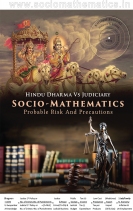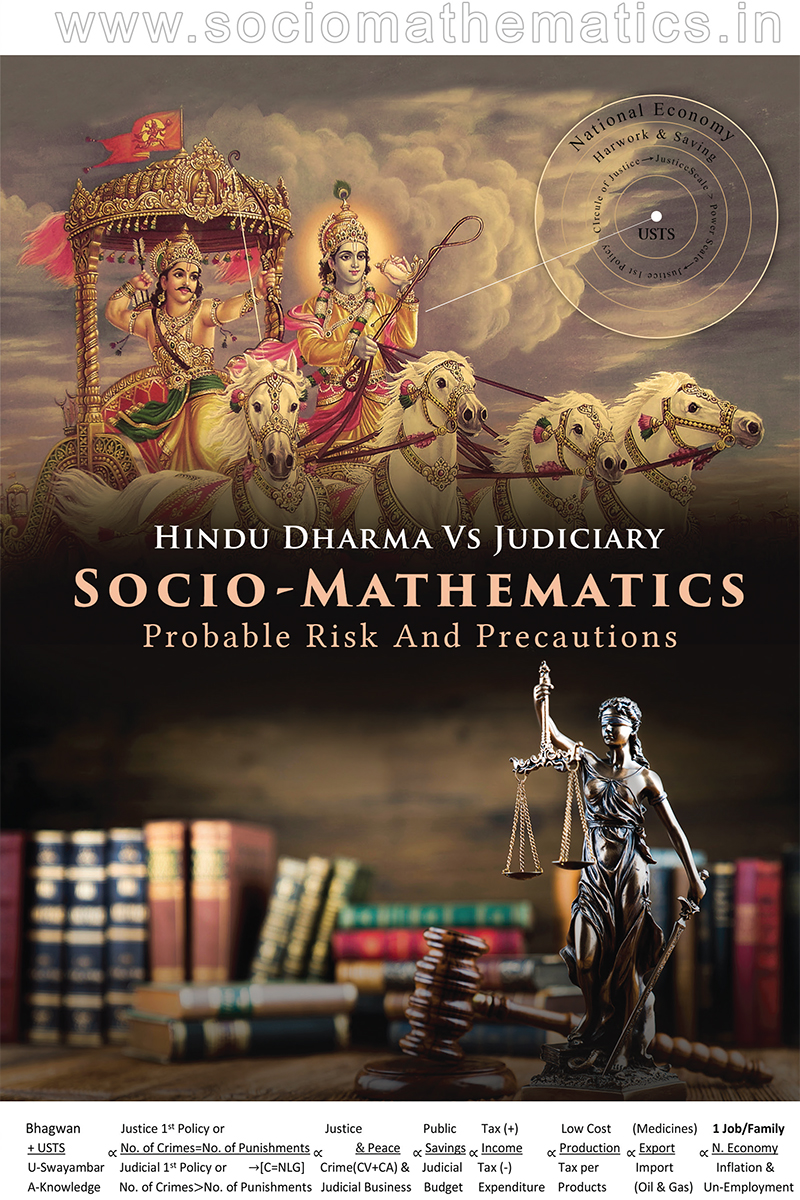
Toolbar


Religion & Spirituality | 49 Chapters
Author: Bighnaraj Sahu
1st policy of Judiciary………. 1000 criminals may be escaped but one innocent should never be punished. Or 1000 innocent victims may live their lives with fire of injustice but one innocent should never be punished. Judicial business depends upon the existence of crimes and criminals (quarrel, fight and war). Women’s empowerment is the main source of quarrel, fight and war.�....
Rules or Glycoside

Glycoside are the compositions of medicine and sugar. There are certain parts of body to which medicine can’t be facilitated. Sugar has the capacity to reach all parts of human body. Henceforth sugar is used as vehicle to facilitate medicine all over the body. Here the sugar used in this composition is called Glycone part whereas the drug incorporated is called Aglycone part. Drug may be medicine or poison depends upon the desire effect or result we want to achieve. Just like Glycosides, rules and regulation are compositions of rules and hidden agenda. Hidden agenda may be profitable for the society and mankind or the hidden agenda may be destructive to society and mankind, depends upon the intension of the rule maker.
Hindu Dharma or Justice vs Judiciary
Judiciary is a pharmaceutical company which manufacture medicine for the treatment of crimes and injustice whereas Hindu Dharma is the pharmaceutical company that create antidote against crimes and injustice. In the presence of Hindu Dharma, business of judiciary can’t be improved. Judiciary has no option but to finish the existence of Hindu Dharma, to save his existence. Hindu dharma try to ignore Swayambar program whereas judiciary provoke multi-directional or direct Swayambar program, to create war like Ramayan and Mahabharat. Because its business depends upon the existence of quarrel, fight and war. In multi-directional Swayambar program, each man (may be married or un-married) become a marriage contestant and each woman (may be married or un-married) become a Swayambara with and without consent. She may not be aware when she already became a Swayambara.
I will describe my story in two phases……….
Phase 1 consist of
1. Existence of judiciary
2. Type of justice
3. Capital square punishment
4. Action vs Reaction theory
5. Punishment (guilty Vs hero)
6. Judiciary enforce fair=unfair
7. Justice Vs Way of justice
8. Judiciary is criminal friendly.
9. Unit of justice and how to make a choice.
In phase 1-I will prove the method of justice is wrong.
In phase 2-I will prove and show the trick and steps hidden in rules and acts to promote no of criminal activities and no of criminals.
01
Existence of Judiciary
Judiciary is the one which is mainly responsible for increment of crimes and no of criminals.
My first question is what is the job of judiciary, why their existence prevails and necessary?
Everybody knows that the job of judiciary is to reduce the crime and the no of criminals by providing punishment to the accused if they are found guilty with all witness, evidence an argument based on logic. In sort judiciary is the problem shooter or disputes solver.
But one point, one most important point we are missing that is, to solve the problems/disputes, there must be any problem/dispute exist. It is clear that, for the existence of judiciary, existence of problems/disputes is so necessary. In mathematical terms the existence of judiciary completely depends upon the presence and existence of problem/disputes or crimes and criminals. Judiciary mainly involve in protecting criminals and taking such steps which will be helpful and more effective to increase the no of criminal activity. So that their existence will be remain as a problem shooter.
Hence main phenomenon is also EXISTENCE.
What is existence, why it is so important?
Everybody knows that power, respect and money with certainty are so important to live.
Aim and objectives of judiciary are…
1. To establish itself
2. To save and protect its business of justice
3. To improve its business of justice
4. To prominent its business of justice
There are two kinds of landlords in villages. Type 1 landlord and type 2 landlord. Type 1 landlord are those usually help people at their bad time. Type 2 landlord are those who creates bad time so that people will seek help from them. Type 1 landlords are really great just because of their good deeds whereas type 2 landlords are selfmade great people. Judiciary is coming under the type 2 landlords.

In the long run I will prove the above equation, by taking the sole phenomenon of justice and tricks and steps hidden. Justice provided in such a way that ensure the crimes and criminals must increase for only the existence of judiciary system. In phase 1 and in phase 2, I will take certain acts and rules framed by judiciary system and how these rules and acts are mainly responsible for promotion and encouragement of crimes and no.of criminals.
02
Types of justice
Generally there are 3 kinds of justice, can be provided by judiciary.
1. Absolute justice.
2. No justice
3. Justice with future revenge against the victim
1. Absolute justice:– Here, the convict is sentenced to death. The family members of convicts are sentenced to death. Such cruel decision taken to save the innocent victim and his family members from the future reaction of convict. This decision also saves the victim from any kind of fearful life.
Absolute justice  existence of judiciary and its business
existence of judiciary and its business
 crimes and criminals
crimes and criminals
 peace and justice
peace and justice
Due to this cruel approach against convicts, criminals will become sage. Result crimes will decrease to great extent. And gradually the no.of crimes will be nil. Judicial business will go down as the existence of judiciary depends upon the existence of crimes and criminals.
2. No justice:– Here, there is no justice provided by judiciary just because neither the convict nor the family member of convict can be sentenced to death. So the judge decide not to gamble the lives of victim and his/her family members. Victim also provides his/her consent, for the safety and security of his family member and to ignore a fearful life.
No justice  crimes and criminals
crimes and criminals
 judiciary existence
judiciary existence
 peace and justice
peace and justice
The reason of existence of judiciary will be finished, as people will choose No justice rather than justice with future revenge against victim. In absence of absolute justice, most of common man will choose No justice.
3. Justice with future revenge against victim:- Here, only the convict is sentenced to jail for a specified time. In this case, the convict or family member of convict will react against the victim and his/her family members. Till then the victim and his/her family will live a fearful life. In the revenge, anyone either the victim or his/her family member may be murdered. In short, the judge gambles the lives of victim and his/her family members just like a bait. Victim is also ready to gamble his life and the lives of his/her family members.
Justice with future revenge against victim  crimes and criminals
crimes and criminals
 judicial business
judicial business
 peace and justice
peace and justice
Justice with future revenge against victim is a curse. It is curse because the victim and his/her family will live a fearful life. Victim and member of his/her family may be murdered at any moment. After murder, judiciary will get another case.
Order of better justice is………………
Absolute justice > No justice > Justice with future revenge against
victim..............(Eq.51)
Absolute justice is better than No justice and No justice is better than Justice with future revenge against victim.
03
Capital Square Punishment
Judiciary theory – thousand criminals may be released but one innocent should never be punished.
Thousand criminals may be released means thousand innocent victims have to live their whole life with the fire of injustice where they will neither live peacefully nor they can die peacefully (called capital square punishment).
Judiciary Exact Theory…
Thousand innocent victims may be punished with capital square punishment but one innocent should never be punished. These 1000 criminal will start their criminal activities again against the society. These criminal activities again compensated by innocent society, called 2nd phase violence of judiciary or 2nd phase violence of judiciary on society, which will sustain the constant demand and existence of judiciary.
Judiciary theory – thousand criminals may be released but one innocent should never be punished. This policy is a glycoside. In this glycoside ‘thousand criminals may be released’ is the aglycone part whereas ‘one innocent should never be punished’ is glycone part. Glycone part increases the adaptability, and acts as a vehicle to facilitate the aglycone part, aglycone part which is poisonous for people or society. The aglycone part provides ‘WAY of escape’ through which criminals can easily escape.
WAY of escape  no.of criminals
no.of criminals
 willpower of criminals
willpower of criminals
 existence of judiciary
existence of judiciary
 innocent victims
innocent victims
 peace and justice.
peace and justice.

Religion & Spirituality | 49 Chapters
Author: Bighnaraj Sahu
Support the author, spread word about the book to continue reading for free.
Socio-Mathematics Probable Risk and Precautions
Comments {{ insta_features.post_zero_count(insta_features.post_comment_total_count) }} / {{reader.chap_title_only}}
{{ (txt.comment_text.length >= 250 ) ? txt.comment_text.substring(0,250) + '.....' : txt.comment_text; }} Read More
{{ txt.comment_text }}
{{txt.timetag}} {{(txt.comment_like_count>0)? txt.comment_like_count : '' }}{{x1.username}} : {{ (x1.comment_text.length >= 250 ) ? x1.comment_text.substring(0,250) + '.....' : x1.comment_text; }} Read More
{{x1.comment_text}}
{{x1.timetag}} {{(x1.comment_like_count>0)? x1.comment_like_count :''}}{{x2.username}} : {{ (x2.comment_text.length >= 250 ) ? x2.comment_text.substring(0,250) + '.....' : x2.comment_text; }} Read More
{{x2.comment_text}}
{{x2.timetag}} {{(x2.comment_like_count>0)?x2.comment_like_count:''}}